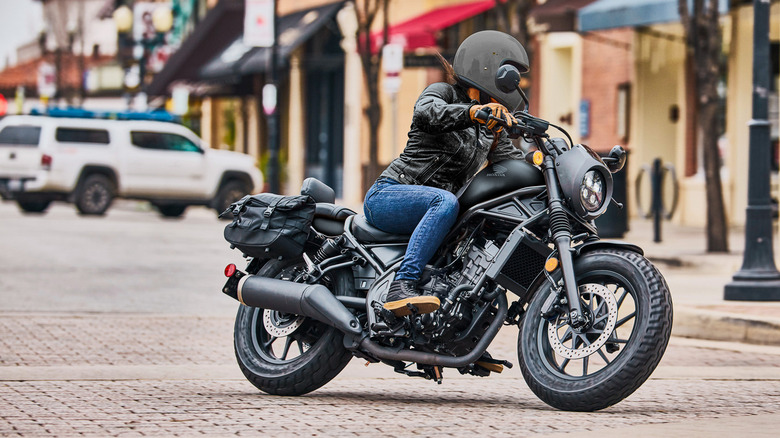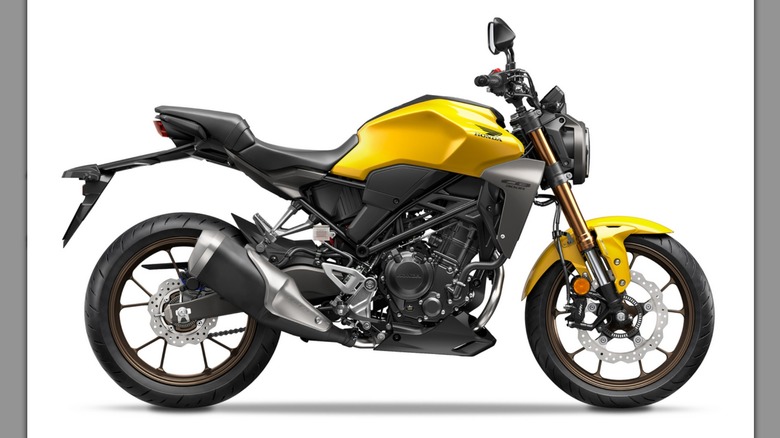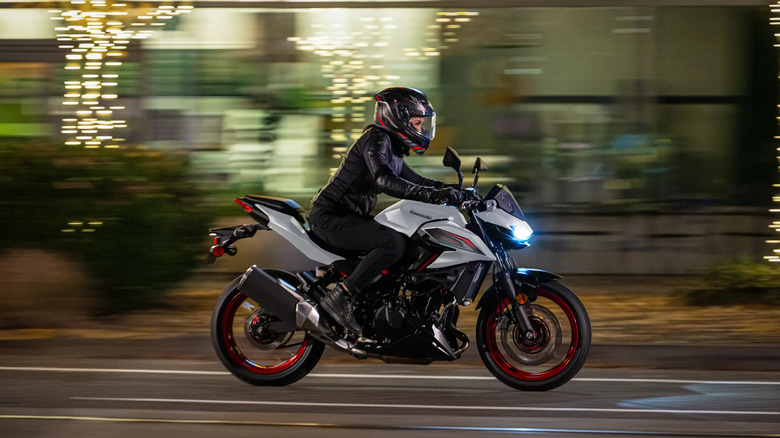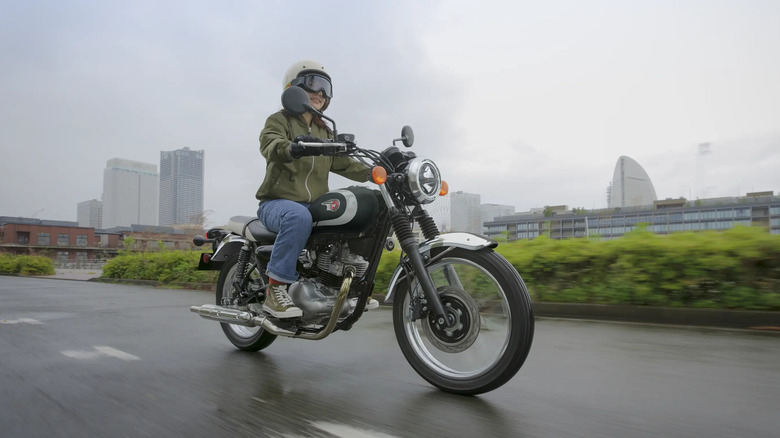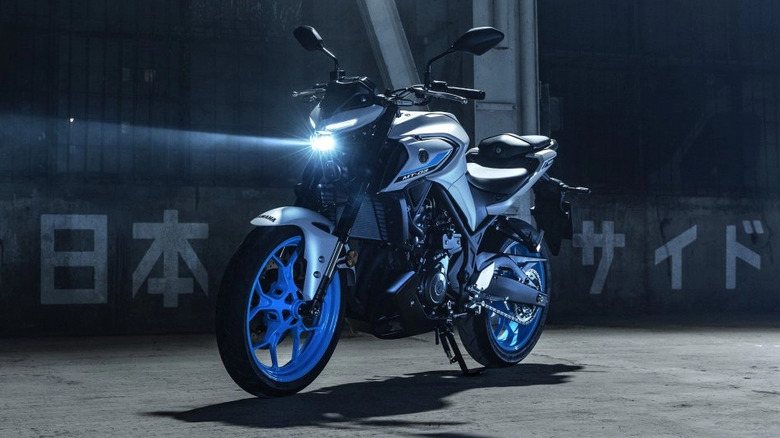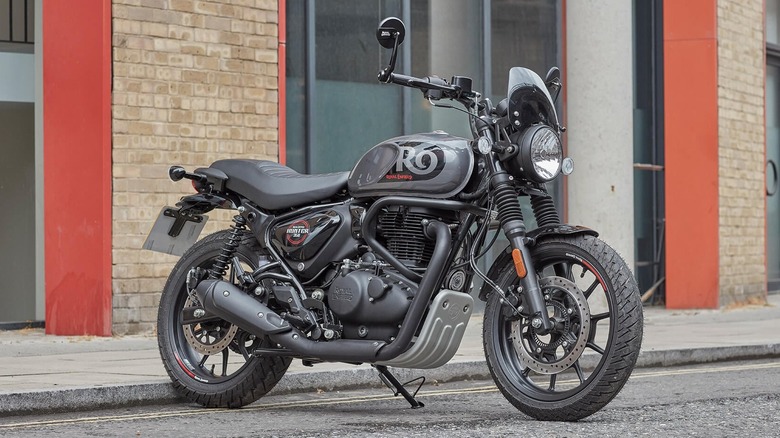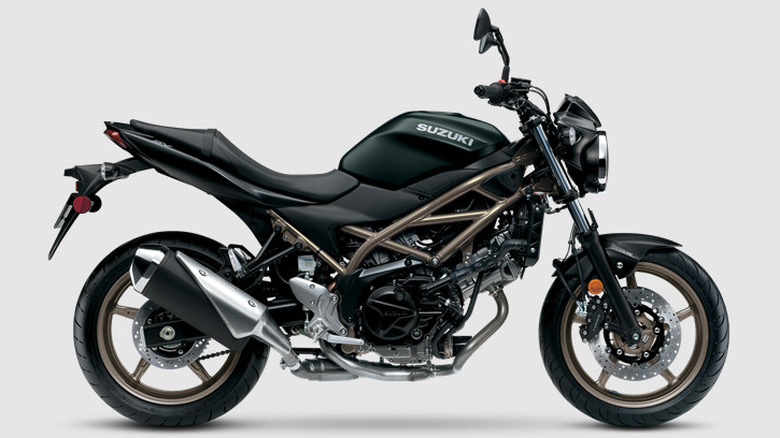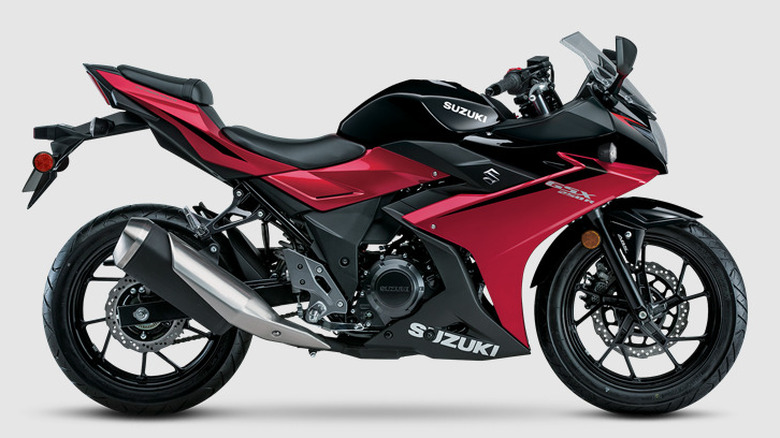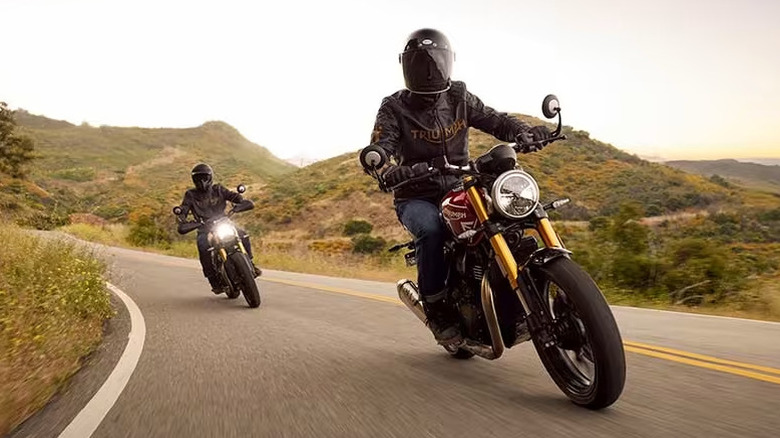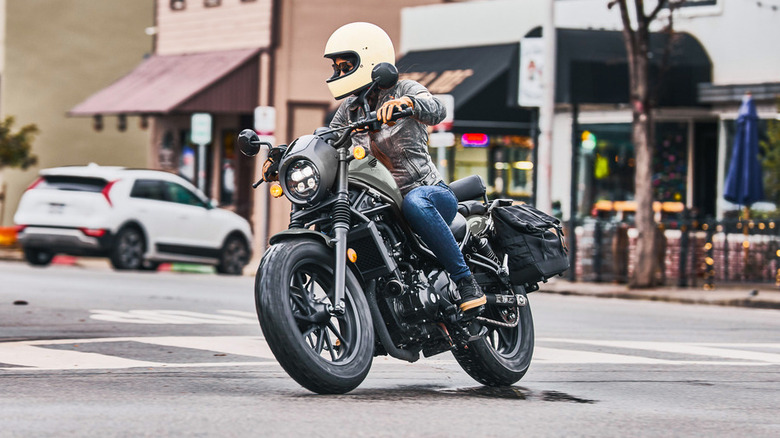13 Beginner-Friendly Motorcycles Worth Buying In 2025 (According To Bikers)
Whether you prioritize sporty riding or comfort, a sense of adventure or a bare-bones approach with an affordable price, there are a lot of motorcycles for beginners to choose from these days. Motorcycle manufacturers from all around the globe offer small and affordable bikes that cover all different bases, and beginner-friendly features to help attract new riders. While there are some contrarians who feel differently, most in the motorcycle world believe that new riders should start with something relatively small, with average power and a lower price tag. The reduced power means a rider is less likely to get into high-speed trouble, and a low price can help with riders who are just getting started enter the arena before investing in something long term.
Combining firsthand experience with professional and owner reviews, we've come up with a list of new motorcycles available today that won't break the bank and they won't be too tough to learn on. Some have automatic transmissions, others have low seat heights and low curb weights, which make them easy to maneuver. All of them are beginner-friendly for one reason or another. A quick note before we dive in: lots of the bikes recommended here are transitioning into their 2026 model year or have already been released with 2026 prices. Where necessary, we note those changes.
Honda Rebel 300
The Honda Rebel is an excellent beginner bike. I recently tested the latest Rebel 1100, one of the biggest cruisers in Honda's lineup, but it was certainly docile enough for beginners. The Rebel 1100 is a bit pricey for a first bike though, so I'd recommend newbies go for the newest version of the Rebel 300. The Rebel 300 uses a 286cc single-cylinder engine that puts out about 25 hp. That's enough for mild highway speeds and all the city-street daily riding you can throw at it. Flat-footing it at a red light should be easy too, with a low seat height of just 27.2 inches.
The 2026 Honda Rebel 300 gets a big update that's valuable to beginners of all sizes: it now has Honda's E-Clutch technology standard. I've used the E-Clutch on multiple other Honda products and even for a seasoned rider who's used to traditional six-speed manuals, it's easy to get used to the system, which requires no use of the clutch lever. Taking off from a stop or coming to a stop, you can simply shift gears with your foot. It makes stalling a virtual impossibility and turns one of the market's most approachable motorcycles even more approachable. The Rebel 300 also starts at an easy-to-swallow $5,949.
Honda CB300R
If you're looking for a slightly more sport-oriented experience from your beginner-friendly Honda, the CB300R is worth a look. Like the Rebel 300, the CB300R uses a 286cc single-cylinder engine, but it still uses a six-speed manual transmission for riders that want a bit more engagement changing their own gears. Combing sport-naked styling and café-racer styling with its circular headlight, the CB300R is a bit of old mixed with a bit of new. The CB300R will also save riders a few hundred dollars compared with the Rebel, with an MSRP of $5,749 for 2025 models.
Lots of riders recommend the CB300R as a first bike, citing its maneuverability as a strong suit. Riders also praise the CB300R for its premium fit and finish, though some do complain about its low levels of power (a common gripe you'll see amongst beginner bikes, but one that's pretty minor). The CB300R is limited when it comes to creature comforts, but that's to be expected in this price range. It's higher off the ground than the Rebel 300, with a 31.5-inch seat height, but the CB300R will also have a bit better view of the road from up there.
Kawasaki Ninja 500
The Ninja, one of the longest standing names in the game, is available in all sorts of sizes, but the most approachable one is the Ninja 500. Powered by Kawasaki's 451cc parallel-twin engine which produces 51 hp and 31.7 lb-ft of torque, the Ninja 500 kicks out more power than most beginner bikes. I've recently spent some time testing the latest Ninja 500, and the power comes on easily with smooth application of the throttle. It's no more intimidating to ride than any of the 300cc bikes on the market.
The basic 2026 Ninja 500 non-ABS model has an MSRP of $6,049 (including $650 destination fee), while upper trim levels with ABS move up to $6,649. If you're looking for a bit more equipment with your beginner bike, the SE version of the Ninja 500 has you covered. On top of the standard equipment it gets a TFT rider screen, keyless start (just keep the key close by in your pocket), frame sliders, a USB-C outlet, knee pads, a tank pad, and radiator screen. The Ninja 500 SE is priced at $7,149, which is a strong price considering all its extra features.
Kawasaki Z500
Essentially a naked version of the Ninja 500, the Kawasaki Z500 offers a fairing-free riding experience which may appeal to newer riders for a number of reasons. For starters, it uses the same approachable-but-powerful 451cc parallel-twin engine as the Ninja 500, and it offers easier access to any maintenance items. While the Ninja 500 offers the choice between ABS and non-ABS models, the Z500 comes standard with ABS across the range, so it is a bit pricier than the base Ninjas, but it's still affordable.
The Z500 has a base MSRP of $6,349 including destination fee, but just like the Ninja 500, the Z500 offers an upgraded SE trim with more features like the rider screen, various tank and knee pads, and a USB-C port. That version is priced at $7,049, saving you $100 over the top-trim Ninja 500. New riders are happy to boast about their positive experience with the Z500, writing lots of positive reviews online that site the Z's looks and highway ridability as positive attributes.
Kawasaki Versys-X 300
At this point in our list, we'd likely be talking about Kawasaki's newest adventure bike that also uses the Kawasaki 451cc engine, the adventerous KLE 500, but it's brand new. There isn't much in the way of riding experience to go on, so it's tough to recommend that particular bike. Thankfully, Kawasaki offers a smaller, less-expensive adventure bike that could offer excellent all-around riding capabilities for new riders: the Versys-X 300.
The Versys-X 300 uses a 296cc two-cylinder engine that produces an adequate 39 hp and 19.2 lb-ft of torque. It has an upright riding position, high handlebars which make manuevering easy, and a rear attachment point that's ready for a top box should you wish to install one. Only one trim level exists, and MSRP for the Versys-X 300 is an affordable $6,449 without any options. Lots of owners and new riders praise it as an excellent first bike, which offers plenty of power for most new riders, provided the bike fits their frame. With its adventure-bike sizing, the seat height is 32.1 inches, which may have some riders on their tip-toes at stop lights.
Kawasaki W230
With dozens of new and refreshed bikes currently available, a robust lineup for 2026 and multiple trim levels available across most of their motorcycles, Kawasaki has one of the strongest offerings of motorcycles on the market today. And as you've seen from their multiple motorcycles on this list, that breadth of talent applies to city-friendly motorcycles and beginner-friendly motorcycles too. One of the least-expensive road-going motorcycles you can buy from Kawi these days is the W230. It's classically styled and with a price tag of $6,134, it's reasonably priced too.
The W230 uses a 233cc single-cylinder air-cooled engine producing just 17 hp and 14 lb-ft, but it only weighs about 315 lbs. The seat height of just 29.3 inches is low enough to fit shorter riders too. Owners praise it as a good bike to learn on, big enough for errands around town, and comfortable enough to use as a daily commuter. There isn't much in the way of optional extras, but that's not where the W230 shines. Its talents lie in providing basic, stylish transportation.
Yamaha MT-03
If you're looking for an inexpensive, fun-to-ride naked sport bike for your first motorcycle, the Yamaha MT-03 should be very close to the top of your list. It's a bike we readily recommend for beginners. With an MSRP for 2026 models of $5,649 (including $650 destination fee), the MT-03 is one of the least-expensive bikes in Yamaha's lineup but it still comes with some pretty impressive features. Yamaha's smartphone connectivity, an assist and slipper clutch, and a USB charging port are all part of the package.
The MT-03's powerplant is a two-cylinder 321cc engine that makes 41.4 hp and 21.7 lb-ft (30.9kW and 29.5 Nm). Weighing in at just 373 lbs, the MT-03 is lightweight enough that it is easy to handle in tight city spaces, and it will return excellent fuel economy. Yamaha estimates it'll return fuel economy as high as 62 mpg. Reviews of the MT-03 praise its impressive power for its size, and its responsive brakes. Owners also praise the MT-03 for its balanced all-around approach to riding with comfort and maneuverability at the heart of its appeal.
Yamaha R3
Unless you skip straight to this part of our list, the Yamaha R3's stats might feel very familiar. Why? Because the R3 shares just its underpinnings, equipment, and numbers with the last bike we covered, the MT-03. The same way Kawasaki uses their 451cc engine across multiple bikes, Yamaha uses their 321cc engine to power multiple machines and they do it with great success. The R3 is Yamaha's smallest and least-expensive full-fairing sport bike, with an as-new MSRP for 2026 of $6,149.
Weight and the powerplant for the R3 are exactly the same as the MT-03: a curb weight of 373 lbs with thrust provided by a 321cc two-cylinder engine. And like the MT-03, owners praise the R3 for its nimble riding characteristics, its reasonable levels of power, and reliability. With its full fairings, beginners to track riding might also be interested in the R3, with impressive acceleration and top speed for the class, easily cresting 100 mph (depending on the rider and conditions of course). Features like a USB charging port, an LCD instrument cluster, and the ability to connect your smartphone via Yamaha's Y-Connect system all make the R3 feel relatively modern too.
Yamaha V Star 250
Much like the Honda Rebel 300 and the Kawasaki W230, the Yamaha V Star 250 offers cruiser styling in a small package with a reasonable price. With a seat height of just 27 inches, riders of all sizes should easily be able to swing a leg over the seat of the V Star. And with a starting price of just $5,449, most new riders should be able to afford one too. The V Star 250 is powered by a 249cc V-Twin engine, which is a relative rarity in the motorcycle market these days. Typically, V-Twin engines are used in much larger motorcycles, and as you've probably seen with the rest of the bikes on our list, small motorcycles typically use single-cylinder or parallel-twin engines.
The V Star's V-Twin engine looks the true part of a classic American cruiser motorcycle, and its low 324-pound curb weight makes it small enough to fit through tight spaces. Some reviewers describe them as reliable, capable of riding at speed on the highway, fuel efficient (Yamaha estimates it will return 78 mpg!) and nimble enough for all the city riding you could want to do. Small bikes like the V Star 250 are also often used for motorcycle training courses like the MSF, so you might even be familiar with one before you ever buy it.
Royal Enfield 350
Royal Enfield has a pretty uniform aesthetic across its motorcycles. Based on the classic look and feel of café bikes, there are a lot of flat-seat, circle-headlight, visually-pleasing bikes available in their lineup. And while most beginners would likely be able to acclimate to some of Royal Enfield's larger 450 or 650 bikes, the 350 bikes will cover a lot of ground without costing as much.
The single-cylinder, air-cooled 349cc engine in Enfield's 350 bikes puts out 20.2 hp and 19.9 lb-ft. It's paired with a five-speed manual transmission. There's the Hunter, Meteor Bullet, and Classic 350, all of which offer a bit of unique styling as a part of their look. If you want a bit of American style added to your British motorcycle, you can even go with the Goan Classic version of the Enfield 350, which offers American-cruiser-style ape-hanger bars. The Hunter 350 is particularly appealing thanks to its low starting price of $4,299 (not including destination fees). Riders hail it as a great starter bike and praise the look and feel of the Enfield, but they do caution larger potential buyers to think about getting a larger or more powerful bike to start off on.
Suzuki SV650
The Suzuki SV650 debuted in 1999, and in the quarter-century since, it has been a popular bike for beginners and experienced riders alike. One of the most versatile bikes in Suzuki's lineup, the SV650 can be a little bit of everything to everyone. It's easy to modify for riders who like to customize and it's got enough power that it will satisfy riders just starting out on their journey, or riders wanting a bit more fun. Power comes from a 645cc V-Twin engine, a relatively rarity in the naked sport-bike world. According to Suzuki U.K., it makes 72 hp and 47 lb-ft (73PS and 64Nm), which is healthy enough for just about any beginner rider. It's also enough power that you can grow into the bike, eventually take it to a track day if you want, and keep up with your more experienced friends once you've done some learning.
While it's a bit more powerful than some of its beginner-bike rivals, the Suzuki SV650 is still reasonably easy to ride. I've ridden multiple SV650 models, some bone-stock and others modified for sportier riding, and they've all been as enjoyable as they were approachable. The exposed trellis frame is an aesthetic staple, and the SV looks more expensive than it is. The base 2025 SV650 has an MSRP of $8,649 (including $600 destination fee). Act fast to find a 2025 model though, as 2026 SV's will go up in price by $350.
Suzuki GSX250R
For nearly 40 years, small Suzuki 250cc versions of the GSX-R (also known as the Gixxer) have offered sporty and affordable choices for riders. Lots of manufacturers have moved up to 300cc engines in their entry level bikes, and the added power that comes along with the increased displacement is welcome for most riders, but the current GSX250R should have enough power for most new riders. It uses a 248cc parallel-twin engine that produces 25 hp, which should be enough for city commuting and learning how to ride, even if it won't exactly thrill from an acceleration standpoint.
It may not be fast, but the GSX250R is extremely economical. Suzuki claims that the GSX250R is capable of 73.6 mpg which gives it over 250 miles of range on a single tank. Owners are quick to point out the GSX250R's lack of speed, but they also praise its reliability, comfort, and the ease with which it can be worked on. With an as-new MSRP for 2025 models of $5,749, the GSX250R is pretty affordable too.
Triumph Speed 400
The Triumph Speed 400 is powered by a 398cc single-cylinder engine that produces 39.5 hp and 27.7 lb-ft. Amongst entry-level beginner bikes, that's a healthy amount of power and it's reasonably light at 375 lbs. According to professional reviews, the Speed 400 is powerful enough to reach nearly 100 mph without issue, so it should have more than enough grunt for any new rider. Owners seem to love the Speed 400's style, though they do admit that it's a bit tall at the seat for some shorter riders.
Then, there's the price. The Speed 400 has an MSRP of just $5,495 (not including destination fees) which is a reasonable price for such a good-looking bike. The Speed 400 has all the classic British styling cues that we associate with café racers, like the exposed engine and exhaust, the circular single headlight, and the flat, simple seating position. There are all sorts of accessories available too like LED turn signals and an upgraded comfort seat.
How we picked these motorcycles
If you want to learn how to ride, there are a lot of different machines you can do it on. The recommendations here are based on multiple factors, but the primary one is experience. Rider reviews play a part in which beginner bikes we recommend, as well as a lot of first-hand experience with many of these motorcycles. There's also a set of stats and specs which we use to evaluate and eventually assess a motorcycle's approachability. Part of approachability is how easy the bike is to ride, with other factors including price, features, and broad appeal.
Depending on your needs for a bike, or maybe even your unique aesthetic desires, this list may shuffle a bit, but the bikes here are strong for beginners of many different shapes and sizes. If you don't see your preferred beginner bike on this list, that doesn't mean you should count it out entirely. Some lists just aren't long enough to fit all the good stuff.

